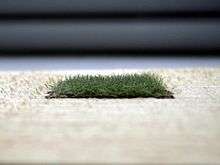Static grass
Static grass is used in railway modelling and miniature wargaming to create realistic-looking "grass" textures. It consists of small coloured fibres charged with static electricity, making them stand on end when sprinkled onto a glue-coated surface.

Static grass is usually used by applying a layer of glue on the surface, then pouring it on and tipping off the excess. It can also be applied with a shaker, also known as a puffer.
Static grass consists of man-made fibres selected for their ability to hold a static electric charge. They are usually a blend of coloured nylon, rayon, or polyester fibres that are used to more realistically replicate grass on a modeller’s layout. The fibres are usually sold by weight in 2, 4, 6, 10 and 12 millimetre lengths, although fibres can be found from as little as 0.5 mm in length.
If using an electronic applicator, the fibres are attracted to the adhesive vertically and "end-on", giving the grass-like effect the modeller requires.
The application sequence is as follows:
- Apply adhesive to the area to be covered with grass;
- Ground the applicator to the adhesive area;
- Load the applicator with fibres;
- Apply the fibres;
- Allow the adhesive to dry;
- Remove excess fibres.
Once the basic technique is mastered, advanced techniques can be learned, such as developing differing lengths, dead grass and creating grass tufts, all of which will lead to a more prototypical scene on the model.

Several companies produce static grass products, including PECO, Woodland Scenics and WW Scenics.
See also
- Rail transport modelling#Scatter (modeling)), alternative that may be just dyed sawdust
External links
- How to Make a Homemade Static Grass Applicator for Model Train Scenery
- Easy Static Grass application by Craig Stocks
- Static Grass Applicator & Static Grass specialists — DoubleO Scenics
- Static Grass Applicator — GrassTech USA